This paper presents an experimental and theoretical studyof the dynamic response of low mass residential buildings andtheir respective space heating peakdemandsfor differentroomtemperature setpoint profiles, with a focus on the impact ofthermal model resolution on the peak demand calculation.Experiments were conducted at two identically constructedand highly instrumented houses. Both houses are built withwood floors, and one of the houses has its floors covered withcarpet for the experiments. The houses’ dynamic response todifferent ramping setpoint profiles is monitored and analyzed.Equivalentandphysically meaningful resistor–capacitor(RC)network thermal models for the purpose of model-basedcontrol are developed for a north zone of the houses. On theexperiment days, the simple and detailed models both accuratelycalculate the same reductions of 21% for a 2 hour rampand 31% for a 3 hour ramp for the house with wood flooring.However, they both underestimate the peak demand for thehouse with carpet flooring. On a peak day with an extremelycold outdoor temperature, the low-order model, whencompared to the detailed model, underestimates the impact ofthe ramping profiles on peak reduction. For a 2 hour ramp, thesimple model predicts a reduction of 5%, while the moredetailed model predicts 12%. For the 3 hour ramp, the modelspredict 16% versus 24%, respectively.
Citation: 2016 Winter Conference, Orlando, FL, Transactions 2016, Vol 122 pt. 1
Product Details
- Published:
- 2016
- Number of Pages:
- 11
- Units of Measure:
- Dual
- File Size:
- 1 file , 4.6 MB
- Product Code(s):
- D-OR-16-022


